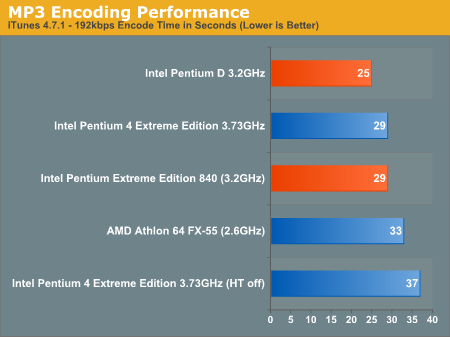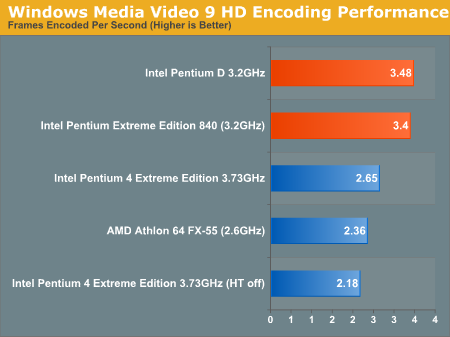Intel Dual Core Performance Preview Part I: First Encounter
by Anand Lal Shimpi on April 4, 2005 2:44 PM EST- Posted in
- CPUs
Encoding Performance
These new dual core CPUs are supposed to usher in a new era of media rich application usage models. They are supposed to enable us to do things that we were never able to do before. Let's find out if that's true or not...
First, we start off with iTunes to test MP3 encoding performance. We took a 12MB .wav file of our own creation and encoded it to a 192kbps MP3 file, measuring how long it took to encode the file.

Once again, we see that the Pentium Extreme Edition 840 is able to offer equal performance to the 3.73EE at 29 seconds. What's truly interesting is that the Pentium D running at 3.2GHz actually offers better performance than the Extreme Edition. We can only assume that 4 threads in iTunes begins to reduce performance, with 2 concurrent threads being the optimal point.
But once again, the performance gains aren't impressive. So far, dual core isn't looking too good.
DivX Encoding Performance
Our DivX tests from previous CPU reviews have shown a pretty sizeable improvement due to Hyper Threading, so we expected a similarly impressive gain due to dual core:

...and we were not disappointed. The Pentium Extreme Edition 840 offered more than a 20% increase in performance in our DivX encoding task when compared to the 3.73GHz single core P4 Extreme Edition.
We also see another example of four threads offering no performance improvement over being able to execute two concurrently, as the Pentium D running at 3.2GHz offers equal performance to the 840.
XviD Encoding Performance

The XviD tests show no real improvement due to dual core, but also don't seem to show much of an improvement due to Hyper Threading either. This just goes to show you that not all encoding tasks will show tremendous benefits.
Windows Media Video 9 Encoding Performance
Once again, we see extremely strong performance from the new dual core chips, offering around a 30% performance improvement at 85% of the clock speed of the current king of the hill.

So, overall encoding performance is pretty strong on the dual core chips from Intel. Let's have a look at one more multi-threaded application before we get to the more interesting tests.










141 Comments
View All Comments
nserra - Tuesday, April 5, 2005 - link
Amd dualcore platform is right here today, the processor is not. And i dont see that a bad thing, upgradable as always been a good thing.#65 "Yes, same will also apply to the AMD's solution. Both CPU cores in dual core Opteron will share same bus and memory controller."
I am not really sure about that, amd always said the processor was being done dualcore since day one that must mean something. Dont forget that socket 939 is dual channel it could be possible to give one memory channel for one processor and the other channel for the other.
matthewfoley - Tuesday, April 5, 2005 - link
You people screaming for the gaming benchmarks, RTFA. Gaming or any other single threaded application will have identical results to a similarly clocked single core proc.ceefka - Tuesday, April 5, 2005 - link
#62 I read the article and think it's a rant, just a rant, no facts, just implications. I can sympathise with the feeling that Intel is let off the hook, for now.I do hope that games will be a substantial part of the benchies once the traditional AMD vs Intel dual core tournament takes place. Remember the pre-release benchies of the Opteron (that Italian thing)?
I also think that shrinking DVD's while typing in MS Word and listening to mp3 is about the maximum of things to do simultaneously. I have to get my head around it as well, you know ;-). It does however open a way to have someting like a home server or HTPC for everything but the most extreme stuff. It could record a TV-show, while watching a DVD and the wife chatting away on another screen.
Some say that dual core will have more benefit in servers because of the typical threaded applications. That's a good point. Can we look forward to a comparison of a 2 and 4-way dual core Opteron vs Xeon on typical server applications, workstation apps and maybe a few games just for fun.
smn198 - Tuesday, April 5, 2005 - link
lol @ #11 "now Intel is going to start eating AMD's lunch"Do you mean eating AMD for lunch? I think I prefer it your way.
RLandon - Tuesday, April 5, 2005 - link
The multitasking benchmarks clearly shows that Windows doesn't deserve to be refered to as an operating system.ceefka - Tuesday, April 5, 2005 - link
The price-difference between a dual and single core might not be too big on an Intel CPU, but you MUST get a new board. So the actual price difference when upgrading is $80 + brand new 955x motherboard. Nice one, Intel. A new board will cost you around $ 100 at least: actual difference $ 180. If AMD can stay under that difference they're at least competitive in pricing.Benchies are promising/impressive though. Wonder what the 64-bit benchies would be. Too bad that the introduction of dual-cores is in different segments (desktop vs server). Can't wait for some traditional Intel vs AMD benching ;)
#2
Read this article
http://www.anandtech.com/cpuchipsets/showdoc.aspx?... page 3, last paragraph.
AMD's Fred Weber finds Hyperthreading a "misuse of resources". AMD have always said two cores are better than a single core acting like one.
defter - Tuesday, April 5, 2005 - link
"INTEL's dual core isn't really dual-core, it's just two CPUs stick together"dual consisting of or involving two parts or components usually in pairs; "an egg with a double yolk"; "a double (binary) star"; "double doors"; "dual controls for pilot and copilot"; "duple (or double) time consists of two (or a multiple of two) beats to a measure": http://dict.die.net/dual/
Yes, two CPU stuck together can be called "dual core".
"the two cpus share the same bus, without any logic in between."
Yes, same will also apply to the AMD's solution. Both CPU cores in dual core Opteron will share same bus and memory controller.
IntelUser2000 - Tuesday, April 5, 2005 - link
130W isn't actually bad. The Xeon MP Potomac had TDP of 125W and max power of 136W, saying probably due to EIST, the difference is much less now. Plus, you aren't running two cores all the time, so if you are playing games only, then you would have 65W power consumption.Hmm... I wonder if the reason 1066MHz is not supported by any of the dual core processors is to dedicate more bandwidth of the Dual-DDRII-667 to integrated graphics. Or maybe we would see Yonah with 1066MHz bus as desktop?
IntelUser2000 - Tuesday, April 5, 2005 - link
falcc - Tuesday, April 5, 2005 - link
No games tested at all? Since when does this happen? Intel doesn't want dual core to look bad so Anandtech doesn't bench ANY games at all.Come on guys, judging by the article below on the Inquirer I'm not the only one who is suspicious.
http://theinquirer.net/?article=22332